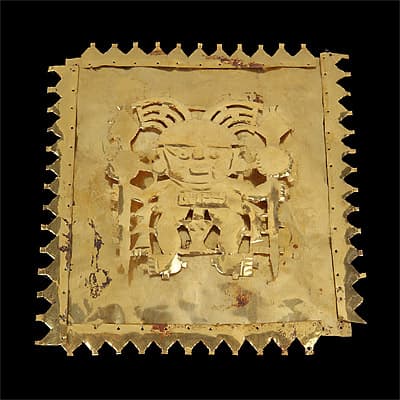
SICÁN-LAMBAYEQUE culture North coast 750 – 1375 AD
Plate 900-1100 AD gold20.5 (h) x 18.5 (w) cm Ministerio de Cultura del Perú: Museo Nacional Sicán, Ferreñafe Photograph: Daniel Giannoni
For the Sicán elite, objects made of gold were often marked by the presence of the ancestor god Naymlap, also known as the Lord of Sicán. He wears a mask with winged eyes and a feather headdress, elaborate pendants, ear ornaments, belt and coccyx protector, and sometimes carries two staffs, maces or sceptres. This is one of six plates found in 1992 in the eastern tomb at Huaca Loro in Lambayeque. Techniques used to make the plate include hammering, rolling, embossing and a cut triangle border.
For the Sicán elite, objects made of gold were often marked by the presence of the ancestor god Naymlap, also known as the Lord of Sicán. He wears a mask with winged eyes and a feather headdress, elaborate pendants, ear ornaments, belt and coccyx protector, and sometimes carries two staffs, maces or sceptres. This is one of six plates found in 1992 in the eastern tomb at Huaca Loro in Lambayeque. Techniques used to make the plate include hammering, rolling, embossing and a cut triangle border.
For the Sicán elite, objects made of gold were often marked by the presence of the ancestor god Naymlap, also known as the Lord of Sicán. He wears a mask with winged eyes and a feather headdress, elaborate pendants, ear ornaments, belt and coccyx protector, and sometimes carries two staffs, maces or sceptres. This is one of six plates found in 1992 in the eastern tomb at Huaca Loro in Lambayeque. Techniques used to make the plate include hammering, rolling, embossing and a cut triangle border.

